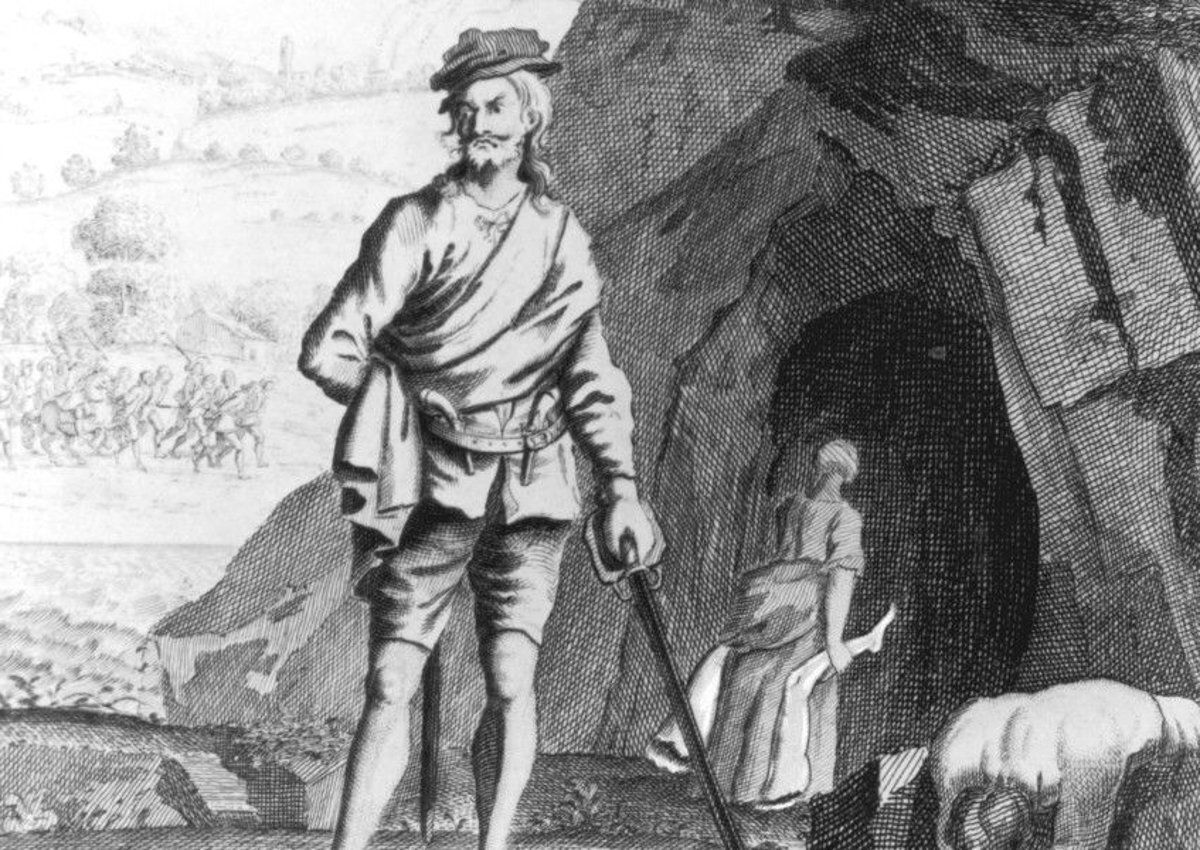
Who was Sawney Bean? Sawney Bean, a name that sends shivers down spines, is a figure from Scottish folklore. He allegedly led a clan of cannibals in the 16th century. Living in a coastal cave, the Bean family reportedly ambushed travelers, dragging them back to their lair for gruesome feasts. But was Sawney Bean real or just a terrifying tale? Historians debate the truth behind the legend. Some argue that the story was a political tool to demonize Scots. Others believe it’s a cautionary tale about the dangers lurking in the wild. Let’s dive into 35 facts about Sawney Bean and his notorious clan.
Key Takeaways:
- Sawney Bean, a 16th-century Scottish figure, led a cannibalistic clan in a coastal cave. Their gruesome activities drew attention, leading to a swift and brutal punishment, leaving a cautionary tale that endures through the centuries.
- The legend of Sawney Bean, though gruesome, has endured through retellings in books, movies, and plays. It reflects the harsh realities of 16th-century Scotland and continues to captivate audiences with its chilling horror tale.
Who Was Sawney Bean?
Sawney Bean is a name that sends shivers down the spine. This infamous figure from Scottish folklore is often depicted as the leader of a cannibalistic clan. Let's dive into the chilling details of his life and legend.
-
Sawney Bean's full name was Alexander Bean. He was born in East Lothian, Scotland, during the 16th century.
-
Bean's family was poor. His father was a ditch digger and hedge trimmer, which didn't provide much for the family.
-
He married a woman named Black Agnes Douglas. Together, they fled to a coastal cave in Bennane Head, Ayrshire.
-
The cave they lived in was almost 200 meters deep. It provided a perfect hiding spot, with its entrance submerged during high tide.
The Cannibal Clan
The Beans didn't just live in the cave; they thrived there, raising a large family. Their way of life was far from ordinary.
-
Sawney and Agnes had 14 children. These children later had children of their own, resulting in a clan of 48 members.
-
The clan survived by ambushing travelers. They would rob and kill their victims, then drag the bodies back to their cave.
-
Cannibalism was their primary means of survival. The clan would dismember and eat their victims, preserving the leftovers for later.
-
They were never seen during the day. The Beans only ventured out at night, making it difficult for authorities to track them.
The Horrors Unveiled
The clan's gruesome activities eventually drew attention. As more people went missing, suspicions grew.
-
Local villagers noticed an increase in disappearances. This led to rumors of a monstrous family living in the area.
-
A search party was formed. King James VI of Scotland sent a group of men to investigate the disappearances.
-
The search party discovered the cave. Inside, they found piles of human remains, confirming the villagers' worst fears.
-
The Beans were captured alive. They were taken to Edinburgh, where they faced trial for their crimes.
The Grim Fate of the Bean Clan
Justice for the Bean clan was swift and brutal. Their punishment reflected the horror of their crimes.
-
Sawney Bean and his clan were sentenced to death. The men were dismembered and left to bleed to death.
-
The women and children faced a different fate. They were burned alive, a common punishment for witches and heretics at the time.
-
Their story became a cautionary tale. It was used to warn people about the dangers lurking in the wilds of Scotland.
The Legend Lives On
Despite the gruesome nature of the tale, Sawney Bean's story has endured through the centuries.
-
The story has been retold in various forms. Books, movies, and even plays have depicted the horrifying tale of Sawney Bean.
-
Some historians doubt the story's authenticity. They believe it may have been exaggerated or entirely fabricated to serve as a moral lesson.
-
The cave still exists today. Known as "Sawney Bean's Cave," it remains a point of interest for tourists and thrill-seekers.
-
The tale has influenced popular culture. Movies like "The Hills Have Eyes" draw inspiration from the legend of Sawney Bean.
-
The story highlights the dark side of human nature. It serves as a reminder of the lengths people can go to survive.
The Historical Context
Understanding the historical backdrop of Sawney Bean's tale provides more insight into why it has persisted.
-
16th-century Scotland was a harsh place. Poverty and lawlessness were rampant, making survival difficult for many.
-
Cannibalism was a known practice. During times of famine, some resorted to eating human flesh to survive.
-
The story may have been used as propaganda. It could have been a way to depict the Scottish Highlands as a dangerous and uncivilized place.
-
King James VI had a vested interest. He was known for his efforts to bring law and order to Scotland, and the tale of Sawney Bean supported his agenda.
The Psychological Impact
The tale of Sawney Bean isn't just a story of horror; it also delves into the psychological aspects of fear and survival.
-
The story plays on primal fears. Fear of the unknown, fear of being hunted, and fear of cannibalism are all deeply rooted in human psychology.
-
It explores the concept of the "other." The Beans were depicted as monstrous and inhuman, highlighting societal fears of those who are different.
-
The tale serves as a moral lesson. It warns against straying from the path of civilization and the consequences of living outside societal norms.
-
The story has a lasting impact. Even today, the legend of Sawney Bean continues to evoke fear and fascination.
Modern Interpretations
The legend of Sawney Bean has evolved over time, taking on new meanings and interpretations.
-
Some see it as a critique of society. The Beans' rejection of societal norms can be viewed as a commentary on the failures of civilization.
-
Others view it as a survival story. It highlights the extreme measures people will take to survive in harsh conditions.
-
The tale has been adapted for modern audiences. Movies, TV shows, and books have reimagined the story to fit contemporary themes.
-
It remains a popular subject for horror enthusiasts. The gruesome details and psychological horror make it a compelling tale for fans of the genre.
The Legacy of Sawney Bean
The story of Sawney Bean has left a lasting legacy, influencing both folklore and popular culture.
-
The tale has become part of Scottish folklore. It is one of the most well-known and enduring legends in Scotland.
-
It has influenced other horror stories. The themes and elements of the Sawney Bean legend can be seen in various horror narratives.
-
The story continues to captivate audiences. Whether as a historical curiosity or a chilling horror tale, the legend of Sawney Bean endures.
The Legacy of Sawney Bean
Sawney Bean's tale has fascinated and horrified people for centuries. His story, whether entirely true or embellished over time, serves as a chilling reminder of humanity's darker side. The legend of a cannibalistic clan living in a cave, preying on travelers, and evading capture for decades is both terrifying and intriguing. It highlights the thin line between civilization and savagery. While some historians debate the authenticity of the tale, its impact on folklore and popular culture is undeniable. Movies, books, and even urban legends have drawn inspiration from the gruesome saga of Sawney Bean. Whether viewed as a cautionary tale or a historical curiosity, the story continues to captivate audiences. As we reflect on these macabre facts, one thing is clear: the legend of Sawney Bean will remain etched in our collective memory for generations to come.
Frequently Asked Questions
Was this page helpful?
Our commitment to delivering trustworthy and engaging content is at the heart of what we do. Each fact on our site is contributed by real users like you, bringing a wealth of diverse insights and information. To ensure the highest standards of accuracy and reliability, our dedicated editors meticulously review each submission. This process guarantees that the facts we share are not only fascinating but also credible. Trust in our commitment to quality and authenticity as you explore and learn with us.


